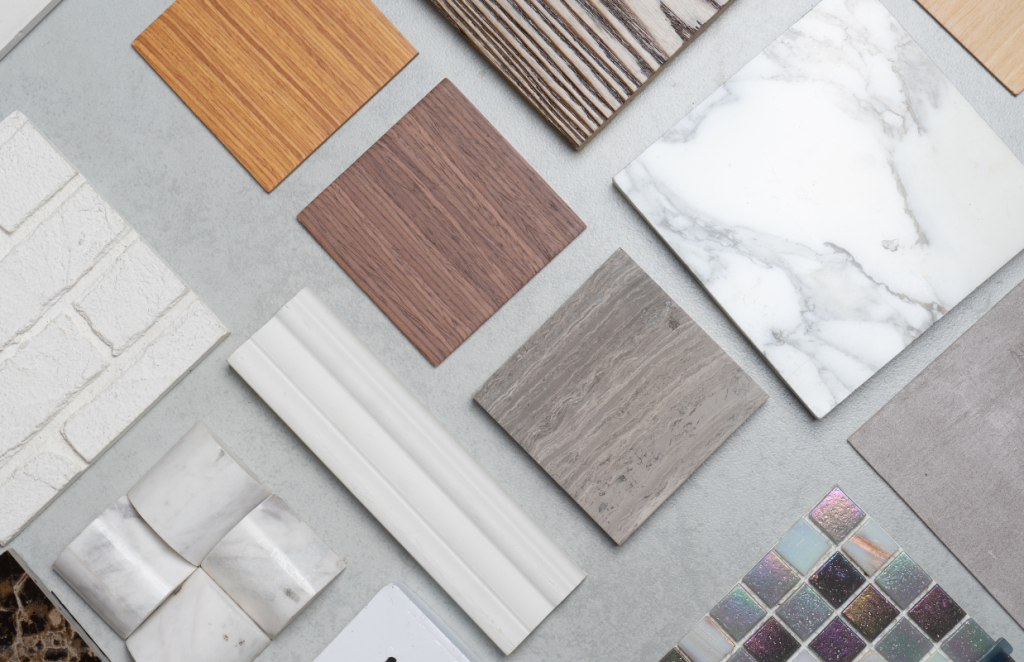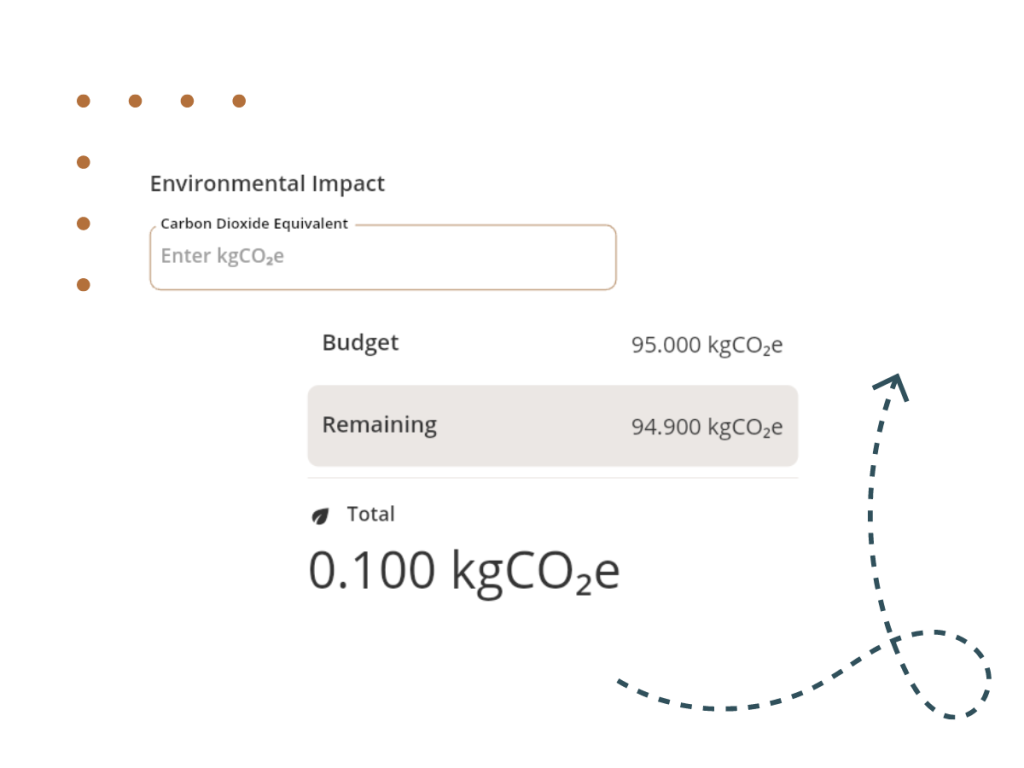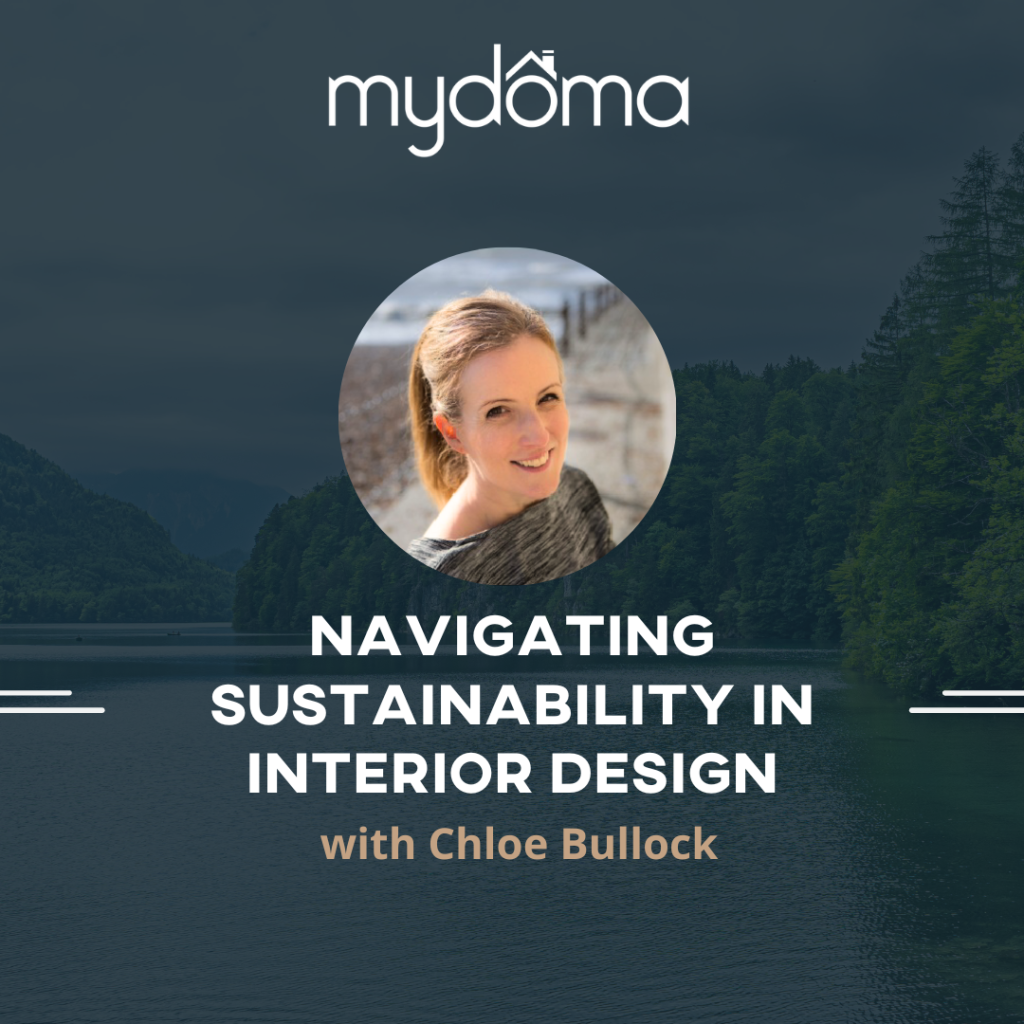In the ever-evolving world of interior design, the shift towards sustainability is not just a trend but a necessity. Recognizing increasing interest in sustainable practices from interor designers, we recently hosted a webinar focused on how to start thinking about sustainability for your business without feeling overwhelmed.
This webinar, led by the renowned interior designer and pioneer of sustainable design, Chloe Bullock, offered a treasure trove of insights on how to harmonize design with eco-friendly practices. As a Mydoma designer, Chloe came to us a few months ago asking if we could help her track her business’s environmental impact in Mydoma. So, together we worked on a brand new feature. During the webinar, we unveiled the new Environmental Impact Calculator feature in Mydoma. This tool allows you to track and manage the carbon footprint of products and services within your interior design projects.
For those who missed the live session or wish to revisit the invaluable discussions, we invite you to access the recording here.
Building on the momentum of this webinar, we wanted to outline 5 key ways to implement sustainability into your interior design business. Explore the ways you can make your design business more sustainable below.
The first step to implementing more sustainable practices into your interior design business is to educate yourself on the impact of the industry on people and the planet.
Engaging in Carbon Literacy training, for example, can help you understand how individual actions contribute to carbon emissions and what steps can be taken to reduce them. Similarly, Net Zero training, aligned with the UN’s Race To Zero commitment, sets forth a clear path for businesses to halve their emissions by 2030 and achieve net zero emissions before 2050. Check out the UN’s Global Compact’s digital learning platform for available courses. These training programs equip you with crucial knowledge to demonstrate your dedication to facilitating sustainable practices within the industry to your clients.
Beyond formal training, sustainability education can extend into regular team meetings, design discussions, and project planning sessions. Sharing articles, attending webinars, and participating in workshops related to sustainability can foster a culture of learning and innovation within your team. This collective approach ensures everyone is on the same page, working together to implement sustainable solutions across projects. Using tools like Giki can help you foster this culture of sustainability within your interior design firm.
Resources like the UN’s Lifestyle Calculator, the WWF’s Footprint Calculator, and The Global Footprint Network Calculator offer valuable insights into the environmental impact of various lifestyle and business operations choices. Encouraging your team to explore these tools can lead to a deeper personal understanding of sustainability and inspire more eco-conscious decisions in both professional and personal spheres.
If you’re a reader, Chloe Bullock suggests How Bad Are Bananas by Mike Berners-Lee.
At the heart of any sustainable interior design project is the selection of materials and suppliers. The materials we choose define the aesthetic and functional quality of our spaces and significantly impact the environment in ways we might not consider upon first glance.
Sustainable material selection starts with an understanding of the environmental implications of various materials. Utilizing the construction material pyramid is an invaluable strategy for this purpose. This pyramid categorizes materials based on their environmental impact, guiding designers towards more sustainable choices. At the top of the pyramid are materials with the highest environmental cost, such as certain metals and plastics, which should be used sparingly. At the base lie biobased materials, which are more sustainable and should be prioritized in projects.
In addition to choosing the right materials, partnering with suppliers who share a commitment to sustainability is crucial. This involves more than just assessing the eco-friendliness of their products; it requires an evaluation of their practices, from the sourcing of raw materials to production processes, and even packaging. Suppliers who are transparent about their environmental impact and actively seek certifications like Cradle to Cradle or Declare labels demonstrate a real commitment to sustainability. These certifications serve as a benchmark for sustainability standards, providing a reliable reference for designers seeking to make responsible choices. Be on the lookout for these certifications when sourcing!
Embracing sustainability in interior design isn’t just about choosing eco-friendly materials; it’s also crucial to focus on reusing and recycling as much as possible. This approach involves bringing new life to previously loved items, like refurbishing vintage furniture or repurposing salvaged wood for your projects. These practices reduce the demand for new materials, thus minimizing waste, and introducing unique elements to your designs.
It’s equally important to consider the entire lifecycle of products when sourcing. This method, known as lifecycle assessment (LCA), pushes you to think about the full journey of a product—from the extraction of raw materials, through its manufacturing and transportation, to its use and eventual end-of-life disposal or recycling. Evaluating products with this comprehensive perspective allows you to make choices that lessen environmental impact throughout the product’s life. Opting for materials that are built to last longer, selecting products designed for easy recycling or repurposing, or choosing items that consume less energy or water can significantly contribute to sustainability.
Encouraging clients to see the value in high-quality, pre-loved pieces. Consider sourcing from online retailers such as Chairish or 1stdibs for antique pieces with flair. Additionally, designing spaces that simplify the recycling process for users ensures that efforts to reduce, reuse, and recycle become a seamless part of daily life.

When we talk about integrating sustainability into interior design, it’s not just about the individual pieces we select but about seeing the bigger picture. Adopting a holistic approach to sustainability means considering every aspect of your design projects in light of their environmental impact. This encompasses not only the choice of materials and suppliers but also the design processes, the functionality of the space, and the well-being of its occupants.
A holistic approach involves designing spaces that are not only aesthetically pleasing but also energy efficient, water efficient, and conducive to good health and well-being. It means thinking about how spaces can adapt to changing needs over time, reducing the need for future alterations and the associated environmental impact. This approach encourages us to create environments that support sustainable living practices, such as spaces that encourage recycling or composting by design or that use natural light and ventilation to reduce energy consumption.
Sustainability is also about the social and economic impacts of our design choices. This includes considering how our selections can support local communities, whether through sourcing locally produced materials or by choosing products from companies that offer fair working conditions and wages to their employees. It’s about recognizing our role in a larger system and making choices that contribute positively to that system.
Furthermore, a holistic approach to sustainability involves continuous learning and adaptation. As new technologies and materials become available, and as our understanding of environmental impact evolves, so too should our design practices. This means staying informed about developments in sustainable design, participating in professional networks and forums, and being willing to experiment and innovate.
If you’re ready to take your sustainable measures to the next step, consider actively measuring and working to reduce your carbon footprint. Understanding the environmental impact of your operations and projects allows you to make informed decisions that can significantly lower your contribution to climate change. It’s about taking responsibility for your business’s role in the broader environmental context and making tangible efforts to lessen that impact.

This is why we created the Mydoma Environmental Impact Calculator. The feature enables you to track the carbon dioxide equivalent (CO2e) emissions associated with the products and services used in your design projects.
In conclusion, embedding sustainability into your interior design business is not just a trend but a commitment to future generations and the health of our planet. By educating yourself and your team, utilizing sustainable materials and suppliers, implementing reuse and recycling strategies, adopting a holistic approach to sustainability, and measuring and reducing your business’s carbon footprint with innovative tools like Mydoma’s Environmental Impact feature, you are taking significant steps towards minimizing environmental impact and fostering a more sustainable future.
These strategies not only elevate your design practice by aligning it with the values of eco-conscious clients but also set a standard within the industry for environmental responsibility. The journey to sustainability is a continuous one, filled with learning, adaptation, and innovation. As designers, we have the power and the responsibility to influence change through our creative choices, making every project an opportunity to contribute positively to the world around us. Let’s embrace this challenge with enthusiasm and commitment, knowing that together, we can create spaces that are not only aesthetically pleasing but also harmonious with the earth.

Get the Webinar Recording
Navigating Sustainability In Interior Design
with Chloe Bullock
Want to continue expanding your knowledge in sustainable design? Watch our recent webinar with Chloe Bullock, renowned interior designer and pioneer of sustainable design.
Become part of our design community. Subscribe for updates and insights!